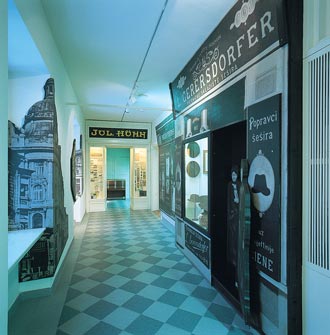Permanent Display 32. Ilica Becomes the Main Commercial Street
 In the middle of the 19th century, it was Jelačić Square and Zagreb’s longest street, Ilica, so called since the 18th century because of the stream of the same name, that became the commercial centre of the united Zagreb. Ilica was also the main city thoroughfare, winding down the valley along the southern slopes of Medvednica towards the west.
In the middle of the 19th century, it was Jelačić Square and Zagreb’s longest street, Ilica, so called since the 18th century because of the stream of the same name, that became the commercial centre of the united Zagreb. Ilica was also the main city thoroughfare, winding down the valley along the southern slopes of Medvednica towards the west.
In the first part of the 19th century, shops are mentioned in Ilica, and taverns, often with very impressive names: The Blue Ball, The Wild Man, The White Swan, The Black Eagle, The Imperial Tavern-Keeper and so on. In the thirties of the 19th century the city magistrate had Ilica and the Upper Town paved, while at the end of the 19th century, asphalt was put on the pavement. It was only in 1910 that Ilica got cobbles of granite for the roadway, and then only as far as Frankopanska Street.
In the seventies, the municipal authorities passed a number of laws about the putting up of signs and shop entrances. In 1863 for the first time Ilica was illuminated, first of all with gas-lighting placed on brackets, replaced in 1890 by candelabras, and in 1907 by electric lamps on posts.
In 1891 a tramway started off down Ilica, horsedrawn first of all, having to wait until 1910 for electrification. It was then that Ilica became the liveliest of all of Zagreb’s commercial streets, in which as well as established Zagreb traders, Viennese shopkeepers like Carl Kastner and Herman Öhler set up their own popular establishments.

In Ilica “in the morning the bustle of the daily fair and the picturesque costumes of the peasantry from the surrounding districts are to be seen, and in the evening, during the corso, a goodly number of Zagreb beauties” noted city councillor Adolf Hudovski in the first printed tourist guide to Zagreb and its Environs, a Guide for Natives and Foreigners (1892).
Nada Premerl

